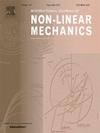Dynamic characteristics of a complex rotor system supported on active dry friction dampers considering friction-stiffening effects
IF 2.8
3区 工程技术
Q2 MECHANICS
International Journal of Non-Linear Mechanics
Pub Date : 2025-02-06
DOI:10.1016/j.ijnonlinmec.2025.105042
引用次数: 0
Abstract
Active dry friction dampers (ADFDs) are promising in rotor vibration suppression. The normal force of ADFD is commonly designed by minimizing responses at a given axial position or maximizing damping ratios. These methods emphasize the maximization of local damping effects while the influences of stiffening effects on system dynamics are ignored. By analyzing the dynamic characteristics of a complex rotor-ADFDs system, this paper intends to disclose the existence of some phenomena due to friction-stiffening effects, which may make the optimization results of those local-damping-oriented methods unsatisfactory. The harmonic balance method is combined with an equivalent linearization technique to relate the unbalance responses with the damper's friction-stiffening effects. After model validation, the effects of rotational speeds, normal forces, and ADFD's installation positions on unbalance responses and ADFD's stiffness coefficients were studied. The results show that the friction-stiffening effects will cause discrepancies in unbalance responses at different positions. Due to the ADFD's stiffening effects, the response variation trends at different positions may differ after the stick-slip transition. An optimum ADFD's normal force exists to minimize rotor unbalance response, though the optimum result could vary for responses at different positions due to friction-stiffening effects. Using the ADFD's stiffening effects, better vibration suppression performance may be achieved at multiple positions even if the damping level of the friction damper is lower.
考虑摩擦加劲效应的主动干摩擦阻尼器支撑的复杂转子系统动态特性
主动干摩擦阻尼器在转子振动抑制方面具有广阔的应用前景。ADFD的法向力通常通过最小化给定轴向位置的响应或最大化阻尼比来设计。这些方法强调局部阻尼效应的最大化,而忽略了加筋效应对系统动力学的影响。通过对复杂转子- adfd系统动态特性的分析,揭示了由于摩擦加筋效应存在的一些现象,这些现象可能会使那些面向局部阻尼的方法的优化结果不理想。将谐波平衡法与等效线性化技术相结合,将不平衡响应与阻尼器的摩擦加筋效应联系起来。在模型验证后,研究了转速、法向力和ADFD安装位置对ADFD不平衡响应和刚度系数的影响。结果表明,摩擦加筋效应会导致不同位置的不平衡响应存在差异。由于ADFD的加筋作用,在粘滑过渡后不同位置的响应变化趋势可能不同。最佳ADFD的法向力存在,以尽量减少转子不平衡响应,虽然最佳结果可能会因不同位置的响应而变化,由于摩擦-加强效应。利用ADFD的加筋效应,即使摩擦阻尼器的阻尼水平较低,也可以在多个位置获得较好的减振性能。
本文章由计算机程序翻译,如有差异,请以英文原文为准。
求助全文
约1分钟内获得全文
求助全文
来源期刊
CiteScore
5.50
自引率
9.40%
发文量
192
审稿时长
67 days
期刊介绍:
The International Journal of Non-Linear Mechanics provides a specific medium for dissemination of high-quality research results in the various areas of theoretical, applied, and experimental mechanics of solids, fluids, structures, and systems where the phenomena are inherently non-linear.
The journal brings together original results in non-linear problems in elasticity, plasticity, dynamics, vibrations, wave-propagation, rheology, fluid-structure interaction systems, stability, biomechanics, micro- and nano-structures, materials, metamaterials, and in other diverse areas.
Papers may be analytical, computational or experimental in nature. Treatments of non-linear differential equations wherein solutions and properties of solutions are emphasized but physical aspects are not adequately relevant, will not be considered for possible publication. Both deterministic and stochastic approaches are fostered. Contributions pertaining to both established and emerging fields are encouraged.

 求助内容:
求助内容: 应助结果提醒方式:
应助结果提醒方式:


